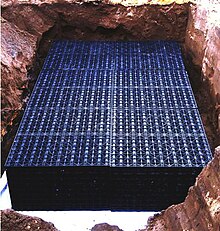Design

Dry wells are excavated pits that may be filled with aggregate or air and are often lined with a perforated casing. The casings consist of perforated chambers made out of plastic or concrete and may be lined with geotextile.[4] They provide high stormwater infiltration capacity while also having a relatively small footprint.[5]
A dry well receives water from entry pipes at its top. It can be used part of a broader stormwater drainage network or on smaller scales such as collecting stormwater from building roofs. It is used in conjunction with pretreatment measures such as bioswales or sediment chambers to prevent groundwater contamination.[6][2]
The depth of the dry well allows the water to penetrate soil layers with poor infiltration such as clays into more permeable layers of the vadose zone such as sand.[7][8]
Simple dry wells consist of a pit filled with gravel, riprap, rubble, or other debris. Such pits resist collapse but do not have much storage capacity because their interior volume is mostly filled by stone. A more advanced dry well defines a large interior storage volume by a concrete or plastic chamber with perforated sides and bottom. These dry wells are usually buried completely so that they do not take up any land area. The dry wells for a parking lot's storm drains are usually buried below the same parking lot.[citation needed]
https://en.wikipedia.org/wiki/Dry_well
No comments:
Post a Comment